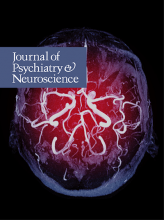A 22-year-old woman presented to the emergency department during the flu season with flu-like symptoms that had persisted for 3 days and reported intense anxiety and sadness, dizziness with movement, insomnia, nausea, periodic “electric shock” sensations and seeing flashes of light. A week prior, she had stopped taking 150 mg venlafaxine. Her symptoms resolved when venlafaxine was reintroduced. It was then tapered over 4 weeks and switched to 5 mg vortioxetine. One year following remission, vortioxetine was discontinued over 2 weeks without onset of discontinuation symptoms.
Antidepressant discontinuation syndrome (ADDS) is a new entity in DSM-5 in the category of medication-induced movement disorders and other adverse effects of medication.1 Symptoms generally begin 2–4 days after abrupt discontinuation of anti-depressants taken continuously for at least 1 month.1 ADDS is often seen during taper or after missed doses with short half-life agents, such as paroxetine and venlafaxine.2–4
Up to 70% of patients prescribed antidepressants occasionally skip doses.5 For diagnosis, ADDS symptoms should not be present before dose reduction and should not be better explained by another psychiatric disorder.1 Symptoms that fit the FINISH mnemonic (flu-like symptoms, insomnia, nausea, imbalance, sensory disturbances, hyperarousal), can be experienced by up to 40% of patients upon abrupt antidepressant discontinuation.2,6–8 The Discontinuation Emergent Signs and Symptoms Scale (DESS) can be used to quantify symptoms.2 ADDS can also include worsening symptoms of the original illness and can be mistaken for a relapse.1,2 In addition, mis-diagnosing the physical symptoms of ADDS can lead to unnecessary medical and laboratory workup.9
Patients must be informed of ADDS when starting treatment and of the differences between ADDS and withdrawal associated with addiction.10 Although withdrawal symptoms and ADDS could have neurobiological similarities, such as a “receptor rebound” phenomenon upon sudden discontinuation,2,7,11,12 there are important differences. Unlike antidepressants, use of drugs of abuse include reinforcing/euphoric effects of the drug and associated drug-seeking behaviour.1 Symptoms of ADDS are associated with short half-life agents, and symptoms are usually mild and short-lived.1
Risk for ADDS is highest with short half-life agents, high doses and rapid taper.1,10 The risk also appears to be higher for those who have taken anti-depressants for 8 weeks or longer,13 experience anxiety symptoms when starting a selective serotonin reuptake inhibitor (SSRI), are taking other centrally acting medications (e.g., anti-psychotics, antihypertensives, antihistamines), are children/adolescents, or have a history of ADDS episodes.2,10 ADDS has been reported with all monoamine oxidase inhibitors (MAOIs) and commonly presents with agitation, movement disorders, and sleep and speech problems.10 ADDS has most commonly been reported for amitriptyline and imipramine among tricyclic antidepressants (TCAs) and paroxetine and venlafaxine among SSRIs.10 Neonatal venlafaxine discontinuation syndrome upon maternal venlafaxine discontinuation before childbirth has been reported.14 ADDS with TCAs and SSRIs commonly presents with flu-like symptoms, insomnia and vivid dreams, and with additional “shock-like” sensations with SSRIs.10 Movement disorders have occasionally been reported with both TCAs and SSRIs.10 Symptoms of ADDS have not been reported with abrupt discontinuation of agomelatine10,15,16 or vortioxetine.10,17
Prevention of ADDS, particularly for short half-life agents, includes a gradual discontinuation over 4 weeks with a slow rate of taper at the end,2,6,7 and a longer taper for those on MAOIs. Importantly, patients need reassurance that ADDS is common, self-limited and often mild.2 If symptoms are severe, restarting the original antidepressant or another antidepressant with a long half-life in the same class can be followed by gradual taper.2 When ADDS symptoms persist despite slow taper,18 abrupt withdrawal options could be considered, particularly when patients prefer a short period of intense symptoms to a longer period of mild symptoms associated with a gradual taper.10 Importantly, there is limited evidence on ADDS management; some studies suggest benefits with fluoxetine for ADDS associated with venlafaxine19 or clomipramine20 and anticholinergic agents in TCA withdrawal.21 Although one recommendation is to switch patients to long-acting antidepressants like fluoxetine before withdrawal of venlafaxine, there are no controlled studies to identify the best option (taper v. substitution).22
Footnotes
The information in this column is not intended as a definitive treatment strategy but as a suggested approach for clinicians treating patients with similar histories. Individual cases may vary and should be evaluated carefully before treatment is provided. The patient described in this column is a composite with characteristics of several real patients.
Competing interests: V. Bhat is supported by the Canadian Biomarker Integration Network for Depression. S. Kennedy reports grants from BMS, Janssen, Lundbeck, Pfizer, Servier, St. Jude Medical, the Ontario Brain Institute, Canadian Institutes of Health Research, Brain Canada, the Ontario Mental Health Foundation and the Ontario Research Fund; is on the advisory boards of and has received personal fees from Allergan, AstraZeneca, BMS, Janssen, Lundbeck, Pfizer, Servier, St. Jude Medical and Sunovion; has received speaker fees from Xian-Janssen; and has received research support from Brain Cells Inc and Clera.









